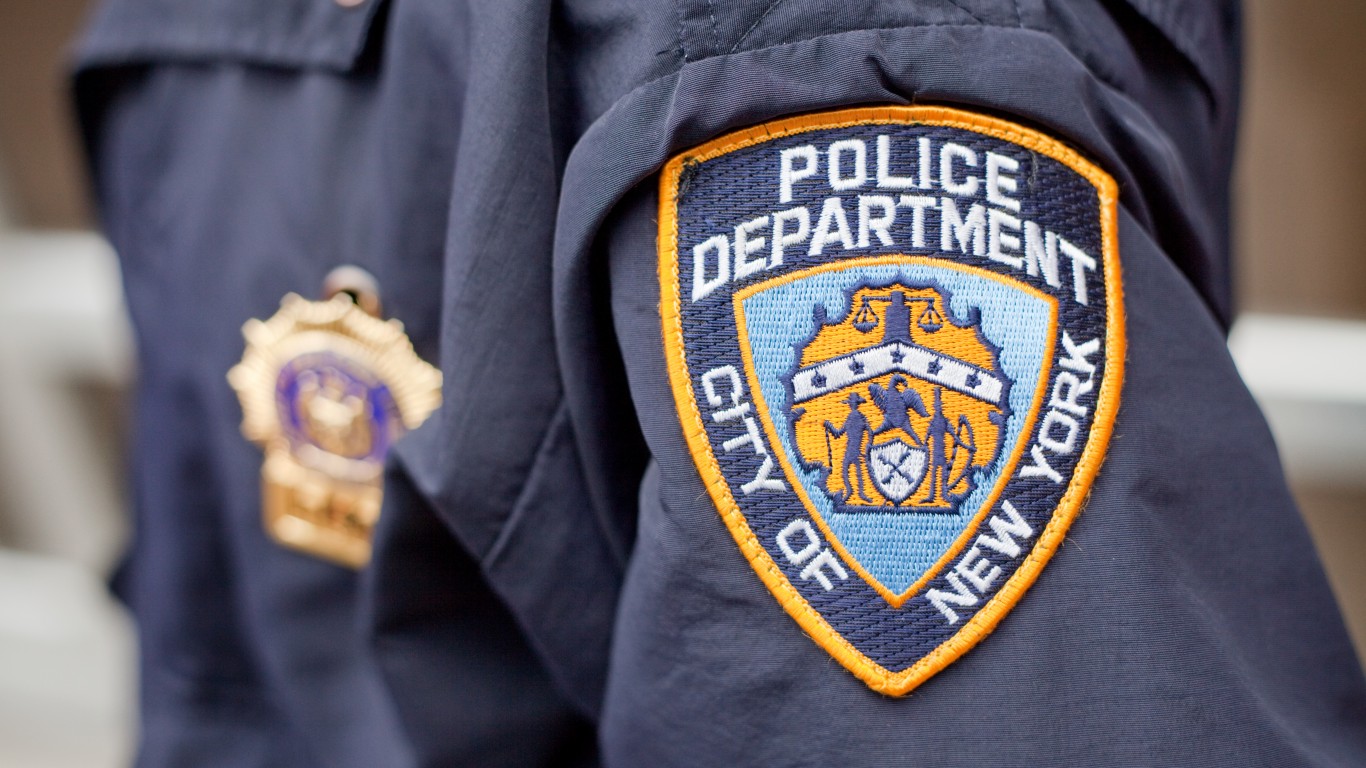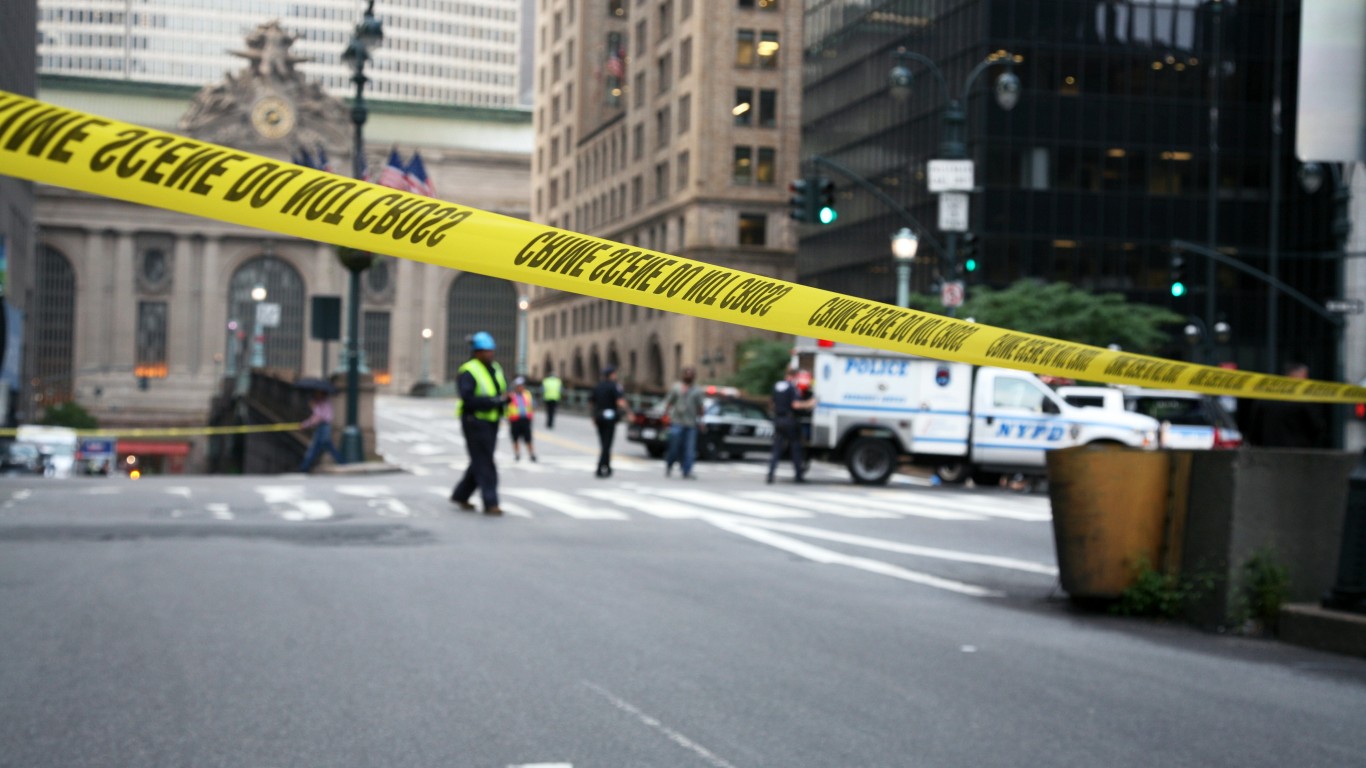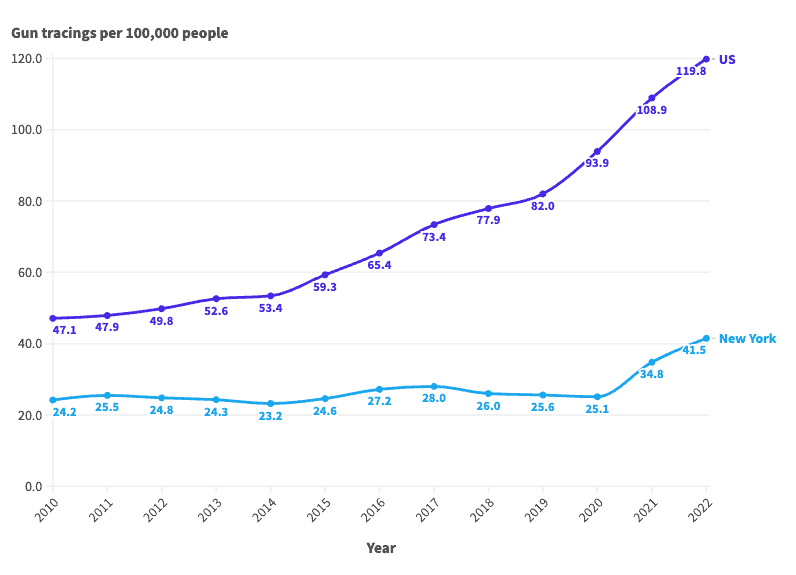
Firearm sales have hit historic highs in the U.S. in recent years, and the ongoing proliferation of firearms may be fueling a rise in gun crime.
When firearms are recovered at a crime scene or taken from a suspect, they are often reported to the Bureau of Alcohol, Tobacco, Firearms, and Explosives for tracing. In these cases, the ATF assists in criminal investigations by using serial numbers and other markings to determine when and where a firearm was originally purchased — and over the last 12 years, firearm-related offenses have been taking up a growing share of federal resources.
Between 2010 and 2022, the number of guns traced by the ATF surged by 174%, from 145,600 to 399,400, climbing by anywhere from 3% to 18% in a single year. Most homicides in the U.S. are committed with a firearm, and over the same period, the national homicide rate climbed by over 50%.
While not all guns traced by the ATF were used in a crime — and not all firearms used for illicit purposes are traced — federal tracing data offers valuable insight into trends and geographic patterns related to gun violence in the United States.
Mirroring the national trend, gun tracings are up sharply in New York state. The ATF traced 8,158 seized firearms in the state in 2022, compared to 4,691 in 2010. Still, adjusting for population, gun crime appears far less common in New York than it is across the U.S. as a whole. In each of the last 13 years, the number of firearm tracings for every 100,000 people in the state was below the comparable national rate.
As of 2022, the most recent year of available data, the ATF traced 41.5 seized firearms for every 100,000 people in the state, the seventh lowest gun-tracing rate among states. New York’s gun-tracing rate has ranked in the 10 lowest of the 50 states every year since 2012.
2010: 4,691 firearms traced by the ATF

- Firearms traced by the ATF in New York, 2010: 24.2 per 100,000 people (14th lowest)
- Firearms traced by the ATF nationwide, 2010: 47.1 per 100,000 people
- New York homicide rate, 2010: 4.5 per 100,000 people (23rd highest)
- U.S. homicide rate, 2010: 4.8 per 100,000 people
2011: 4,972 firearms traced by the ATF

- Firearms traced by the ATF in New York, 2011: 25.5 per 100,000 people (14th lowest)
- Firearms traced by the ATF nationwide, 2011: 47.9 per 100,000 people
- New York homicide rate, 2011: 3.9 per 100,000 people (24th lowest)
- U.S. homicide rate, 2011: 4.7 per 100,000 people
2012: 4,850 firearms traced by the ATF

- Firearms traced by the ATF in New York, 2012: 24.8 per 100,000 people (10th lowest)
- Firearms traced by the ATF nationwide, 2012: 49.8 per 100,000 people
- New York homicide rate, 2012: 3.5 per 100,000 people (21st lowest)
- U.S. homicide rate, 2012: 4.7 per 100,000 people
2013: 4,784 firearms traced by the ATF

- Firearms traced by the ATF in New York, 2013: 24.3 per 100,000 people (10th lowest)
- Firearms traced by the ATF nationwide, 2013: 52.6 per 100,000 people
- New York homicide rate, 2013: 3.3 per 100,000 people (20th lowest)
- U.S. homicide rate, 2013: 4.5 per 100,000 people
2014: 4,585 firearms traced by the ATF

- Firearms traced by the ATF in New York, 2014: 23.2 per 100,000 people (9th lowest)
- Firearms traced by the ATF nationwide, 2014: 53.4 per 100,000 people
- New York homicide rate, 2014: 3.1 per 100,000 people (20th lowest)
- U.S. homicide rate, 2014: 4.4 per 100,000 people
2015: 4,863 firearms traced by the ATF

- Firearms traced by the ATF in New York, 2015: 24.6 per 100,000 people (7th lowest)
- Firearms traced by the ATF nationwide, 2015: 59.3 per 100,000 people
- New York homicide rate, 2015: 3.1 per 100,000 people (15th lowest)
- U.S. homicide rate, 2015: 4.9 per 100,000 people
2016: 5,378 firearms traced by the ATF

- Firearms traced by the ATF in New York, 2016: 27.2 per 100,000 people (8th lowest)
- Firearms traced by the ATF nationwide, 2016: 65.4 per 100,000 people
- New York homicide rate, 2016: 3.2 per 100,000 people (16th lowest)
- U.S. homicide rate, 2016: 5.4 per 100,000 people
2017: 5,565 firearms traced by the ATF

- Firearms traced by the ATF in New York, 2017: 28.0 per 100,000 people (7th lowest)
- Firearms traced by the ATF nationwide, 2017: 73.4 per 100,000 people
- New York homicide rate, 2017: 2.8 per 100,000 people (14th lowest)
- U.S. homicide rate, 2017: 5.3 per 100,000 people
2018: 5,085 firearms traced by the ATF

- Firearms traced by the ATF in New York, 2018: 26.0 per 100,000 people (5th lowest)
- Firearms traced by the ATF nationwide, 2018: 77.9 per 100,000 people
- New York homicide rate, 2018: 2.9 per 100,000 people (17th lowest)
- U.S. homicide rate, 2018: 5.0 per 100,000 people
2019: 4,974 firearms traced by the ATF

- Firearms traced by the ATF in New York, 2019: 25.6 per 100,000 people (6th lowest)
- Firearms traced by the ATF nationwide, 2019: 82.0 per 100,000 people
- New York homicide rate, 2019: 2.9 per 100,000 people (16th lowest)
- U.S. homicide rate, 2019: 5.1 per 100,000 people
2020: 4,897 firearms traced by the ATF

- Firearms traced by the ATF in New York, 2020: 25.1 per 100,000 people (4th lowest)
- Firearms traced by the ATF nationwide, 2020: 93.9 per 100,000 people
- New York homicide rate, 2020: 4.2 per 100,000 people (18th lowest)
- U.S. homicide rate, 2020: 6.5 per 100,000 people
2021: 6,896 firearms traced by the ATF

- Firearms traced by the ATF in New York, 2021: 34.8 per 100,000 people (7th lowest)
- Firearms traced by the ATF nationwide, 2021: 108.9 per 100,000 people
- New York homicide rate, 2021: 3.4 per 100,000 people
- U.S. homicide rate, 2021: 7.7 per 100,000 people
2022: 8,158 firearms traced by the ATF

- Firearms traced by the ATF in New York, 2022: 41.5 per 100,000 people (7th lowest)
- Firearms traced by the ATF nationwide, 2022: 119.8 per 100,000 people
- New York homicide rate, 2022: 4.4 per 100,000 people (13th lowest)
- U.S. homicide rate, 2022: 7.3 per 100,000 people

| Year | Firearm tracings per 100,000 people in New York | Firearm tracings per 100,000 people in the US | Total firearms traced by the ATF in New York | Total firearms traced by the ATF in the US |
|---|---|---|---|---|
| 2022 | 41.5 | 119.8 | 8,158 | 399,397 |
| 2021 | 34.8 | 108.9 | 6,896 | 361,587 |
| 2020 | 25.1 | 93.9 | 4,897 | 306,686 |
| 2019 | 25.6 | 82.0 | 4,974 | 269,250 |
| 2018 | 26.0 | 77.9 | 5,085 | 254,700 |
| 2017 | 28.0 | 73.4 | 5,565 | 239,175 |
| 2016 | 27.2 | 65.4 | 5,378 | 211,384 |
| 2015 | 24.6 | 59.3 | 4,863 | 190,538 |
| 2014 | 23.2 | 53.4 | 4,585 | 170,344 |
| 2013 | 24.3 | 52.6 | 4,784 | 166,426 |
| 2012 | 24.8 | 49.8 | 4,850 | 156,346 |
| 2011 | 25.5 | 47.9 | 4,972 | 149,276 |
| 2010 | 24.2 | 47.1 | 4,691 | 145,604 |
100 Million Americans Are Missing This Crucial Retirement Tool
The thought of burdening your family with a financial disaster is most Americans’ nightmare. However, recent studies show that over 100 million Americans still don’t have proper life insurance in the event they pass away.
Life insurance can bring peace of mind – ensuring your loved ones are safeguarded against unforeseen expenses and debts. With premiums often lower than expected and a variety of plans tailored to different life stages and health conditions, securing a policy is more accessible than ever.
A quick, no-obligation quote can provide valuable insight into what’s available and what might best suit your family’s needs. Life insurance is a simple step you can take today to help secure peace of mind for your loved ones tomorrow.
Click here to learn how to get a quote in just a few minutes.
Thank you for reading! Have some feedback for us?
Contact the 24/7 Wall St. editorial team.



